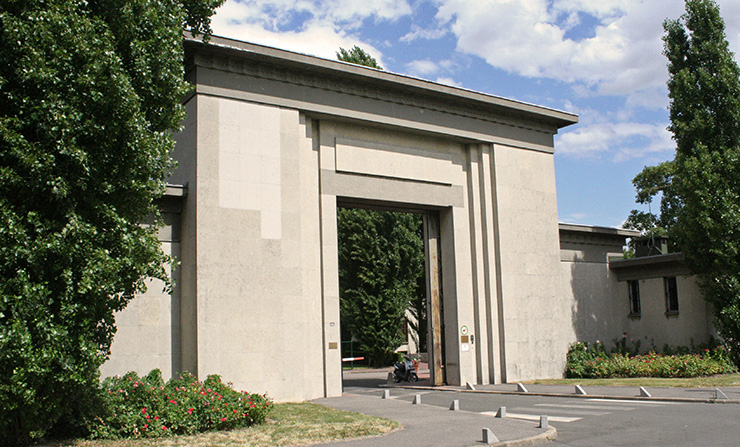
Thiais Cemetery entrance
African-American Gravesites in Paris
Monique Wells, founder of Entree to Black Paris, has lived in Paris with her husband, Tom Reeves since 1992. She was named Black Culture and Heritage VIP in Paris. Monique has authored several wonderful books and itineraries, including Paris Reflections: Walks Through African American Paris and the Black Pearl Walk. Absorb her rare insights on important African-American Gravesites in Paris.
Most travelers here do not know that there are many African-American gravesites in Paris that are significant. In fact, there are physical traces of over 200 years of African-American presence there. Many who decided to reside in Paris permanently enjoyed some measure of fame during their lives. Yet very little has been written about what became of these renowned persons.
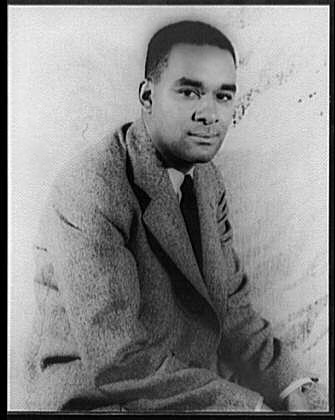
Richard Wright
Richard Wright (1908-1960) is one of many African-Americans of distinction interred in or around Paris.
The famed author of Black Boy and Native Son resided in Paris from 1947 until his death. He reportedly died of a heart attack, but there has been much speculation that he was actually murdered. His wife Ellen arranged a small commemorative service for him at the chapel of Paris’ famous Père Lachaise cemetery. It was followed by Wright’s cremation at the cemetery’s Columbarium. Wright’s ashes were placed in Niche 848, where they remain to this day.
The remains of William Gardner Smith (1927-1974), are also at Père Lachaise cemetery. Americans will likely find the story of his ultimate disposition shocking. Smith was a contemporary of Richard Wright and a member of the expatriate circle of African-Americans who lived in Paris during the 1950s and 60s. A novelist and journalist, he died from esophageal cancer at a clinic in Thiais, a suburb that lies south of Paris. Like Wright, his funeral was held at Père Lachaise Cemetery and his body was cremated. His ashes were placed in Niche 15926. Unlike Wright, Smith’s ashes would not remain in their “final” resting place.
In France, graves are leased, and failure to renew the lease can result in the exhumation of the remains of the deceased. Each cemetery is governed by the laws of the municipality in which the cemetery is located. The term of the lease, or concession ranges from five years to perpetuity. The amount of time allowed to reclaim a concession for which payment is overdue and the disposition of the remains exhumed from abandoned concessions differ from one city or village to another.
In Paris, these decisions are made by the Service des Cimetières, which is part of the Department of Parks, Gardens, and Green Spaces.
When the term of the lease is about to expire, the family or the person or organization that is legally responsible for the affairs of the deceased is expected to submit payment to the cemetery for the next term. In Smith’s case, his family did not renew the concession. His remains were taken from the niche and scattered over the ground in Jardin du Souvenir (Garden) at Père Lachaise Cemetery in 1983. This garden, created specifically for the purpose of dispersing the ashes of the deceased, is located in Division 77, near the Porte de la Dhuys entrance.
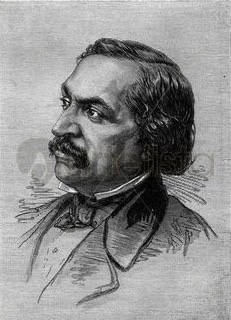
Victor Séjour
Victor Séjour (1816-1874), another African-American writer, is buried at Père Lachaise Cemetery. Séjour was a free man of color from Louisiana who moved to Paris in 1836. He is credited as the first African-American to publish a work of fiction (“Le Mulâtre,” 1837).
Sejour was a playwright and enjoyed considerable success prior to suffering a reversal of fortune. He died a pauper, succumbing to tuberculosis. His grave is located in Section 15. Though the inscription is badly worn, the tomb is identifiable by a book sculpted in stone at its foot. Sejour’s gravesite is unique among all those described here because it is perpetual. It will remain intact as long as it is well tended.
Across town, in bucolic Montmartre, lies the final resting place of another great African-American. Jazz trumpeter James Arthur Briggs (1899-1991) is buried in Division 9 of the Montmartre Cemetery. Briggs came to Europe after World War I. He was a member of the Harlem Hellfighters’ band but did not serve during the war because he was too young. Once the war was over, he joined other band members who returned to Europe to fuel the fire that their military jazz band had begun.
Briggs was one of the Americans interned by the Nazis when he refused to leave Paris prior to their invasion. He survived detention in two concentration camps to continue to play and teach jazz in the post-war era.
The remains of these four African-Americans of note can be found in cemeteries located in Paris suburbs.
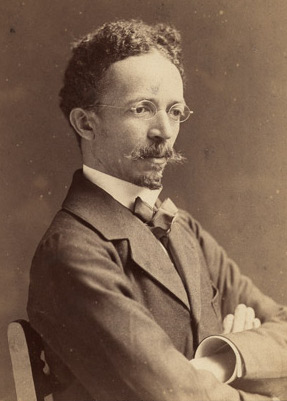
Henry Ossawa Tanner
Henry Ossawa Tanner (1859-1937), a master painter who was revered by African-American artists who visited Paris during the early 20th century, is buried south of Paris in Sceaux Cemetery. He arrived in Paris via London in 1896, on his way to Rome. Falling in love with the city, he made it his permanent home. Tanner enjoyed great success, capturing several awards at critically acclaimed art shows and having his works purchased by the French government. He was named a Chevalier of the Legion of Honor in 1923. He died in his sleep in his Paris apartment and studio. His painting, Sand Dunes at Sunset, Atlantic City (oil on canvas, c. 1886), hangs in the White House.
When Tanner’s biographer Marcus C. Bruce appeared at a Paris book signing for Henry Ossawa Tanner — A Spiritual Biography in 2002, he brought with him rose petals from the rosebush that grows at the foot of Tanner’s grave to place in the volumes that he inscribed. Tanner’s tomb is in the northeast corner of Division 8, on the northernmost line of graves of that division.
Sidney Bechet (1897-1959) was one of the greatest soprano saxophone players of all time. A passionate man of uneven temperament, he traveled extensively throughout Europe and lived in Paris periodically from 1919 until 1931. He returned to Paris in 1949 to perform at the city’s first International Jazz Festival which was a resounding success. He moved to the greater Paris permanently in 1950. Bechet died of lung cancer on his 62nd birthday. He was laid to rest in Division G of the cemetery at Garches, a western suburb of Paris.
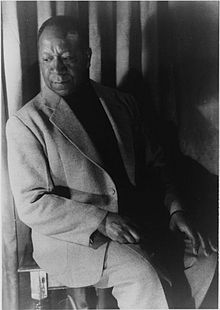
Beauford Delaney
The story of painter Beauford Delaney’s (1901-1979) gravesite is perhaps the most poignant of those described here. Delaney was one of many painters who came to Paris during the post-WWII years, arriving in the autumn of 1953. Though he lived in poverty, he spent many productive years in the Montparnasse district and the nearby suburb of Clamart. His paintings were displayed in numerous group and solo expositions during this time, including a retrospective that featured the works created during his Paris years at the Studio Museum in Harlem in 1978.
Buried at the Parisian municipal cemetery in Thiais, Delaney was laid to rest in what Americans would call a pauper’s grave. His tomb lies in Division 86, an unkempt area where numerous graves are unmarked. Delaney’s grave is recognizable only by a small ceramic flower arrangement. The fees for Delaney’s concession had gone unpaid since 1985, but in 2009, concerned friends and admirers of his work contributed funds to erect a permanent marker there.
The remains of painter Hugh Lawrence (Larry) Potter (1925-1966) are also at Thiais cemetery. Potter was a contemporary of Beauford Delaney, as well as his friend. He lived from 1956 to 1958, went back to the U.S. for a few months, and then returned to Paris and established a permanent residency here. Potter’s work evolved from impressionistic to abstract during the last years of his life. After his premature death from an asthma attack, he was buried in Division 44 at Thiais.
Like William Gardner Smith, his concession was not renewed. His remains were cremated and strewn in the Jardin du Souvenir at Thiais cemetery (Division 94) in 1998/99 (exact year unknown). Coincidentally, Division 94 is located adjacent to Division 86, where Delaney lies.
Access to Cemeteries by Public Transportation
Père Lachaise:
16, rue du Repos
75020 Paris
Tel.: 33(0)1 55 25 82 10
Metro: Père Lachaise or Philippe Auguste
Buses: 26, 60, 61, and 69
Montmartre:
20, avenue Rachel
75018 Paris
Tel.: 33(0)1 53 42 36 30
Metro: Blanche or Place de Clichy
Buses: 95, 80, 74, 54 and 30
Sceaux:
170 rue Houdan
92330 Sceaux
Tel.: 33(0)1 46 61 19 03 (Sceaux Tourist Office)
RER: Robinson (Line B)
RER/Bus: Bourg la Reine (Line B), then Bus 192 (direction Robinson RER) to Cimetière
Bus: 128
Garches:
rue de Suresnes
92380 Garches
Tel.: 33(0)1 01 47 95 66 66 (Garches town hall)
RER/Bus: La Défense (Line A), then Bus 360 (direction Hôpital de Garches) to Sylvain Vigneras
Thiais:
261, route de Fontainebleau
94320 Thiais
Tel.: 33(0)1 41 73 27 30
Metro/Bus: Porte d’Italie (Line 7), then Bus 185 (direction Rungis-Marché International) to Porte Sud
RER/Bus: Pont de Rungis (Line C), then Bus 319 (direction Rungis-Marché International) to Le Cor de Chasse
RER/Bus: Choisy le Roi (Line C), then Bus 103 (direction Rungis-Marché International) to Porte Sud
